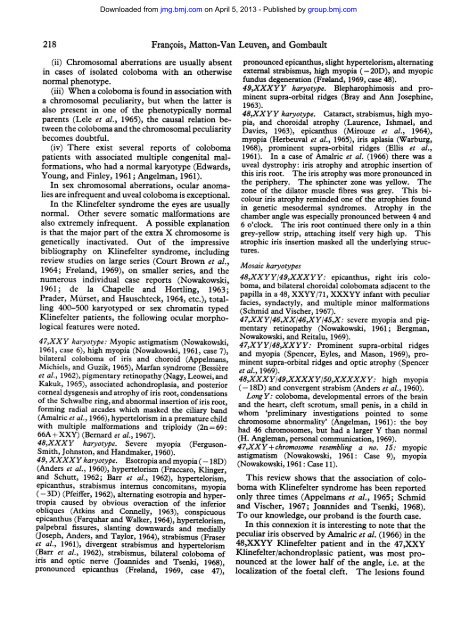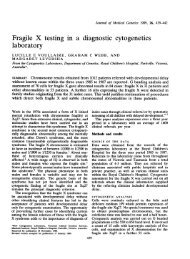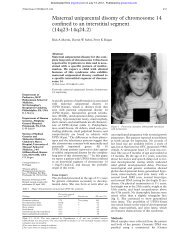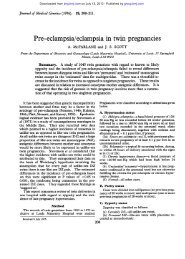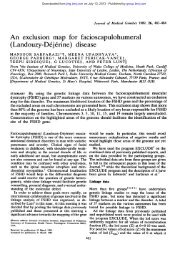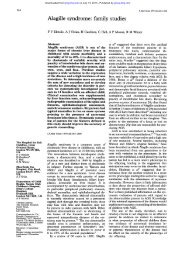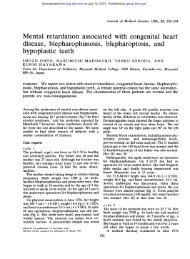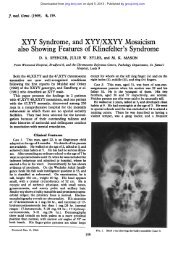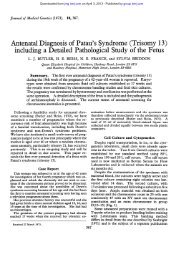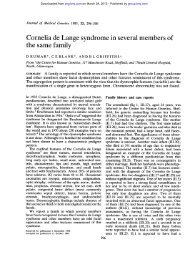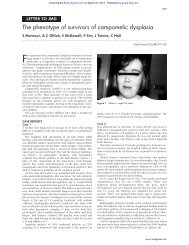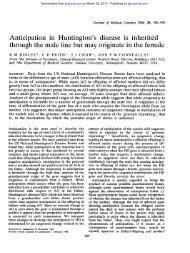Uveal Coloboma and True Klinefelter Syndrome - Journal of Medical ...
Uveal Coloboma and True Klinefelter Syndrome - Journal of Medical ...
Uveal Coloboma and True Klinefelter Syndrome - Journal of Medical ...
Create successful ePaper yourself
Turn your PDF publications into a flip-book with our unique Google optimized e-Paper software.
218<br />
Downloaded from<br />
jmg.bmj.com on April 5, 2013 - Published by group.bmj.com<br />
(ii) Chromosomal aberrations are usually absent<br />
in cases <strong>of</strong> isolated coloboma with an otherwise<br />
normal phenotype.<br />
(iii) When a coloboma is found in association with<br />
a chromosomal peculiarity, but when the latter is<br />
also present in one <strong>of</strong> the phenotypically normal<br />
parents (Lele et al., 1965), the causal relation between<br />
the coloboma <strong>and</strong> the chromosomal peculiarity<br />
becomes doubtful.<br />
(iv) There exist several reports <strong>of</strong> coloboma<br />
patients with associated multiple congenital malformations,<br />
who had a normal karyotype (Edwards,<br />
Young, <strong>and</strong> Finley, 1961; Angelman, 1961).<br />
In sex chromosomal aberrations, ocular anomalies<br />
are infrequent <strong>and</strong> uveal coloboma is exceptional.<br />
In the <strong>Klinefelter</strong> syndrome the eyes are usually<br />
normal. Other severe somatic malformations are<br />
also extremely infrequent. A possible explanation<br />
is that the major part <strong>of</strong> the extra X chromosome is<br />
genetically inactivated. Out <strong>of</strong> the impressive<br />
bibliography on <strong>Klinefelter</strong> syndrome, including<br />
review studies on large series (Court Brown et al.,<br />
1964; Frol<strong>and</strong>, 1969), on smaller series, <strong>and</strong> the<br />
numerous individual case reports (Nowakowski,<br />
1961; de la Chapelle <strong>and</strong> Hortling, 1963;<br />
Prader, Murset, <strong>and</strong> Hauschteck, 1964, etc.), totalling<br />
400-500 karyotyped or sex chromatin typed<br />
<strong>Klinefelter</strong> patients, the following ocular morphological<br />
features were noted.<br />
47,XXY karyotype: Myopic astigmatism (Nowakowski,<br />
1961, case 6), high myopia (Nowakowski, 1961, case 7),<br />
bilateral coloboma <strong>of</strong> iris <strong>and</strong> choroid (Appelmans,<br />
Michiels, <strong>and</strong> Guzik, 1965), Marfan syndrome (Bessiere<br />
et al., 1962), pigmentary retinopathy (Nagy, Leowei, <strong>and</strong><br />
Kakuk, 1965), associated achondroplasia, <strong>and</strong> posterior<br />
corneal dysgenesis <strong>and</strong> atrophy <strong>of</strong> iris root, condensations<br />
<strong>of</strong> the Schwalbe ring, <strong>and</strong> abnormal insertion <strong>of</strong> iris root,<br />
forming radial arcades which masked the ciliary b<strong>and</strong><br />
(Amalric et al., 1966), hypertelorism in a premature child<br />
with multiple malformations <strong>and</strong> triploidy (2n = 69:<br />
66A + XXY) (Bernard et al., 1967).<br />
48,XXXY karyotype. Severe myopia (Ferguson-<br />
Smith, Johnston, <strong>and</strong> H<strong>and</strong>maker, 1960).<br />
49, XXXXY karyotype. Esotropia <strong>and</strong> myopia (-18D)<br />
(Anders et al., 1960), hypertelorism (Fraccaro, Klinger,<br />
<strong>and</strong> Schutt, 1962; Barr et al., 1962), hypertelorism,<br />
epicanthus, strabismus internus concomitans, myopia<br />
(- 3D) (Pfeiffer, 1962), alternating esotropia <strong>and</strong> hypertropia<br />
caused by obvious overaction <strong>of</strong> the inferior<br />
obliques (Atkins <strong>and</strong> Connelly, 1963), conspicuous<br />
epicanthus (Farquhar <strong>and</strong> Walker, 1964), hypertelorism,<br />
palpebral fissures, slanting downwards <strong>and</strong> medially<br />
(Joseph, Anders, <strong>and</strong> Taylor, 1964), strabismus (Fraser<br />
et al., 1961), divergent strabismus <strong>and</strong> hypertelorism<br />
(Barr et al., 1962), strabismus, bilateral coloboma <strong>of</strong><br />
iris <strong>and</strong> optic nerve (Joannides <strong>and</strong> Tsenki, 1968),<br />
pronounced epicanthus (Frol<strong>and</strong>, 1969, case 47),<br />
Frangois, Matton-Van Leuven, <strong>and</strong> Gombault<br />
pronounced epicanthus, slight hypertelorism, alternating<br />
external strabismus, high myopia (-20D), <strong>and</strong> myopic<br />
fundus degeneration (Frol<strong>and</strong>, 1969, case 48).<br />
49,XXXYY karyotype. Blepharophimosis <strong>and</strong> prominent<br />
supra-orbital ridges (Bray <strong>and</strong> Ann Josephine,<br />
1963).<br />
48,XXYY karyotype. Cataract, strabismus, high myopia,<br />
<strong>and</strong> choroidal atrophy (Laurence, Ishmael, <strong>and</strong><br />
Davies, 1963), epicanthus (Mirouze et al., 1964),<br />
myopia (Herbeuval et al., 1965), iris aplasia (Warburg,<br />
1968), prominent supra-orbital ridges (Ellis et al.,<br />
1961). In a case <strong>of</strong> Amalric et al. (1966) there was a<br />
uveal dystrophy: iris atrophy <strong>and</strong> atrophic insertion <strong>of</strong><br />
this iris root. The iris atrophy was more pronounced in<br />
the periphery. The sphincter zone was yellow. The<br />
zone <strong>of</strong> the dilator muscle fibres was grey. This bicolour<br />
iris atrophy reminded one <strong>of</strong> the atrophies found<br />
in genetic mesodermal syndromes. Atrophy in the<br />
chamber angle was especially pronounced between 4 <strong>and</strong><br />
6 o'clock. The iris root continued there only in a thin<br />
grey-yellow strip, attaching itself very high up. This<br />
atrophic iris insertion masked all the underlying structures.<br />
Mosaic karyotypes<br />
48,XXYY/49,XXXYY: epicanthus, right iris coloboma,<br />
<strong>and</strong> bilateral choroidal colobomata adjacent to the<br />
papilla in a 48, XXYY/71, XXXYY infant with peculiar<br />
facies, syndactyly, <strong>and</strong> multiple minor malformations<br />
(Schmid <strong>and</strong> Vischer, 1967).<br />
47,XXY/46,XX/46,XY/45,X: severe myopia <strong>and</strong> pigmentary<br />
retinopathy (Nowakowski, 1961; Bergman,<br />
Nowakowski, <strong>and</strong> Reitalu, 1969).<br />
47,XYY/48,XXYY: Prominent supra-orbital ridges<br />
<strong>and</strong> myopia (Spencer, Eyles, <strong>and</strong> Mason, 1969), prominent<br />
supra-orbital ridges <strong>and</strong> optic atrophy (Spencer<br />
et al., 1969).<br />
48,XXXY/49,XXXXY/50,XXXXXY: high myopia<br />
(- 18D) <strong>and</strong> convergent strabism (Anders et al., 1960).<br />
Long Y: coloboma, developmental errors <strong>of</strong> the brain<br />
<strong>and</strong> the heart, cleft scrotum, small penis, in a child in<br />
whom 'preliminary investigations pointed to some<br />
chromosome abnormality' (Angelman, 1961): the boy<br />
had 46 chromosomes, but had a larger Y than normal<br />
(H. Angleman, personal communication, 1969).<br />
47,XXY+ chromosome resembling a no. 15: myopic<br />
astigmatism (Nowakowski, 1961: Case 9), myopia<br />
(Nowakowski, 1961: Case 11).<br />
This review shows that the association <strong>of</strong> coloboma<br />
with <strong>Klinefelter</strong> syndrome has been reported<br />
only three times (Appelmans et al., 1965; Schmid<br />
<strong>and</strong> Vischer, 1967; Joannides <strong>and</strong> Tsenki, 1968).<br />
To our knowledge, our prob<strong>and</strong> is the fourth case.<br />
In this connexion it is interesting to note that the<br />
peculiar iris observed by Amalric et al. (1966) in the<br />
48,XXYY <strong>Klinefelter</strong> patient <strong>and</strong> in the 47,XXY<br />
<strong>Klinefelter</strong>/achondroplasic patient, was most pronounced<br />
at the lower half <strong>of</strong> the angle, i.e. at the<br />
localization <strong>of</strong> the foetal cleft. The lesions found


